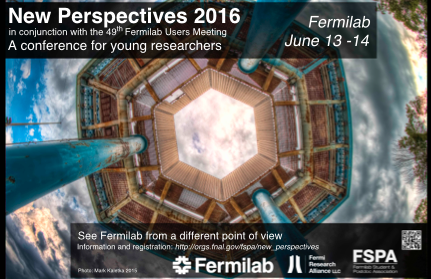Conveners
Session 2: Collider Physics and the Fermilab Test Accelerators
- Joel Butler (Fermilab)
Mr
Christopher Clarke
(Wayne State University)
13/06/2016, 11:00
Charge-parity violation (CPV) is important to explaining the matter-antimatter
asymmetry in the universe. CPV is predicted in the Standard Model through the complex nature of the quark mixing matrix. CPV has been measured in $B$ meson decays through the interference of different decay paths to the same final state. In decays of $D$ mesons CPV is predicted to be very small and is not yet...
Benjamin Kreis
(Fermilab)
13/06/2016, 11:15
Forty million times per second, the Compact Muon Solenoid (CMS) experiment at CERN's Large Hadron Collider detects the products of the highest energy collisions ever created in a laboratory. The experiment's charged particle trackers, calorimeters, and muon detectors, which total over 100 million individual detecting elements, are used to measure the properties of the standard model and to...
Mr
Andrew Johnson
(University of Colorado)
13/06/2016, 11:30
A search for new physics in events with two high-$p_T$ taus is performed using 2.2 $\text{fb}^{-1}$ of data collected by the CMS experiment during 2015 at sqrt(s)=13TeV. The search is centered around the heavy neutral gauge boson known as the Z', though additional models are also considered. Observations are consistent with the Standard Model expectations. The diTau mass spectrum is examined,...
Mr
Ali Celik
(Texas A&M University)
13/06/2016, 11:45
A search for supersymmetry (SUSY) using vector-boson fusion (VBF) tagged jets is presented using 19.5 fb$^{-1}$ of data from proton-proton collisions at center of mass energy of 8 TeV, collected by the CMS detector in 2012. Final states containing at least two leptons are expected in pair production of charginos and neutralinos. The LHC has started its operation at 13 TeV in June 2015, where...
Xuan Chen
(University of Illinois at Chicago)
13/06/2016, 12:00
The pixel detector is an integral part of the CMS silicon tracker, designed to measure the position and momentum of charged particles produced in high-energy collisions at the Large Hadron Collider (LHC). Over the coming years, the LHC will deliver increased instantaneous luminosity to the CMS detector, soon reaching double the design luminosity. The phase 1 upgrade of the CMS pixel detector...
Frank Jensen
(University of Colorado)
13/06/2016, 12:15
In supersymmetric extensions of the Standard Model, the Higgsino and gluino are expected to play an important role in stabilizing the Higgs boson mass parameter. With specific assumptions about the LSP and NLSP masses, CMS results at 8 TeV for gluino-mediated supersymmetry with two Higgs bosons and missing energy in the final state have set a lower bound on the gluino mass at approximately 1...
Mr
Matthew Andorf
(Northern Illinois University)
13/06/2016, 12:30
A proof-of-principal optical stochastic cooling (OSC) experiment will take place in the Integrable Optics Test Accelerator (IOTA) at Fermilab. OSC is a technique that may yield cooling rates orders of magnitude faster than what is achievable with presently used microwave-based stochastic cooling systems, and can thus play an important role in future high luminosity machines. In OSC light from...
Mr
Alex Halavanau Halavanau
(Northern Illinois University), Mr
Aliaksei Halavanau
(APC)
13/06/2016, 12:45
Microlens arrays are fly-eye type light condensers that are commonly used to improve the uniformity of light beams. A common problem of the photocathode in electron accelerators is distortion of the laser spot due to non ideal conditions at all stages of the amplification. Such a laser spot at the cathode may produce asymmetric charged beams that will result in degradation of the beam quality...
